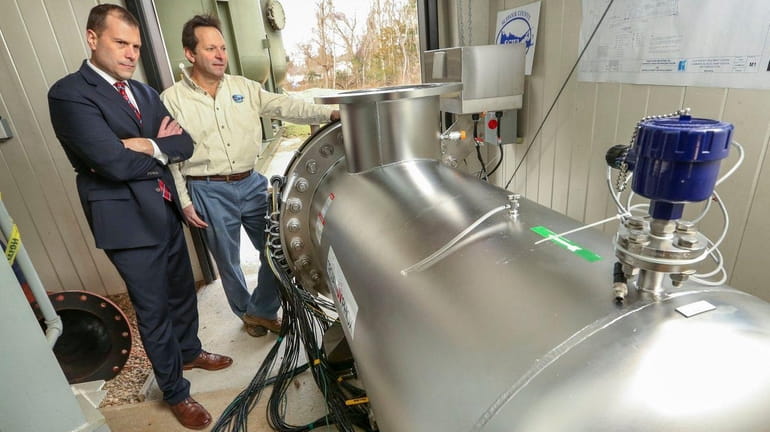State plans to set limits for chemical found in LI groundwater

Jeffrey Szabo, chief executive of the Suffolk County Water Authority, left, and Joseph Roccaro, a water quality engineer, look over an ultraviolet reactor on Thursday, Dec. 22, 2016, that treats water for the contaminant 1,4-dioxane. The state plans to set a drinking water limit for the probable carcinogen that is not regulated federally but has been found in trace amounts throughout Long Island's groundwater supply. Credit: Newsday / John Paraskevas
New York State plans to set a drinking water limit for a probable carcinogen that is not regulated federally but has been found in trace amounts throughout Long Island’s groundwater supply.
A new 12-person Drinking Water Quality Council is being vetted and its first task will be to examine 1,4-dioxane and make recommendations to the health commissioner as to safe levels allowed in water, said Brad Hutton, deputy commissioner in the state Health Department’s Office of Public Health.
“We’re going to move on an aggressive time frame,” Hutton told Newsday.
The state had been waiting in vain for federal action.
In February, Gov. Andrew M. Cuomo, state health and environmental officials and local politicians asked the U.S. Environmental Protection Agency to set a national drinking water standard for 1,4-dioxane, a man-made chemical used in manufacturing but also widely found as a byproduct in cleaning and personal care products.
EPA responded, saying the agency had set a nonbinding health advisory level for 1,4-dioxane, was evaluating risks associated with its use and the chemical was on a list for possible future regulation, acting EPA Region 2 Administrator Catherine R. McCabe wrote in a March 27 letter. She said New York could act on its own.
“New York is not willing to wait,” Hutton said.
New York would be the first to set a specific maximum contaminant level that water suppliers must follow. Other states have set nonbinding standards. Currently, 1,4-dioxane falls under a state blanket regulation for unregulated organic chemicals.
Citizens Campaign for the Environment Executive Director Adrienne Esposito said urgency was key. “The quicker we do this, the more the public is protected,” she said.
The Drinking Water Quality Council — members include state officials, scientists and water representatives — will hold a public meeting on Long Island in June.
“I think it’s very good that the health department has acted on this particular chemical,” said Assemb. Steve Englebright (D-Setauket), who chairs the Environmental Conservation Committee. “It’s almost ubiquitous now in our water supply. It’s everywhere.”
He said he hoped the council would establish proactive criteria moving forward. “I wish there were a blueprint of how the next and the next and the next will be handled,” Englebright said.
The state took notice of 1,4-dioxane after results of a nationwide survey of water suppliers revealed Long Island far outpaced other parts of the country in the prevalence of the chemical. Seventy-one percent of districts tested locally detected the chemical at levels posing a 1 in a million cancer risk after prolonged exposure.
Nationally, 6.9 percent of water districts tested found similar concentrations.
“Establishing a maximum contaminant level is a key, vital, first step toward eradicating 1,4-dioxane from our water,” state Sen. Todd Kaminsky (D-Long Beach) said.
No permitted removal treatment exists in New York. But Suffolk County Water Authority is about to launch a pilot treatment system to remove 1,4-dioxane from water.
“As long as this council has knowledgeable individuals who are committed to keeping the public safe, this is a good thing,” Chief Executive Jeff Szabo said, but financial help needs to be offered if a limit is set.
For the authority alone, installing and running 1.4-dioxane treatment could cost $200 million.
“It’s a huge impact on customers,” Szabo said.
A portion of the new $2.5 billion clean water fund would be available to water suppliers who need to treat water to remove contaminants, Hutton said.
The Long Island Water Conference, a coalition of more than 50 industry groups and suppliers, said water districts would need time and money to comply with the regulations, spokesman Dennis Kelleher said.
“We have been looking for the EPA or the state to give us some kind of guidance,” he said.
Gilgo-related search continues ... Trump hush money trial latest ... Gang member stands trial ... What's up on LI
Gilgo-related search continues ... Trump hush money trial latest ... Gang member stands trial ... What's up on LI
